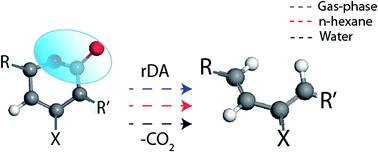On the mechanism of retro-Diels–Alder reaction of partially saturated 2-pyrones to produce biorenewable chemicals†
Abstract
Partially saturated 2-pyrone molecules undergo ring-opening and decarboxylation via retro-Diels–Alder (rDA) reaction. Density functional theory (DFT) simulations were utilized to calculate the intrinsic activation barrier and reaction energies of the steps involved in rDA reaction of biomass-derived 5,6-dihydro-4-hydroxy-6-methylpyran-2-one (5DHHMP), 4-hydroxy-3,6-dimethyl-pyran-2-one (4HDMP) and 4-hydroxy-6-(2-oxo-propyl)-3,6-dihydro-pyran-2-one (4HOPP). The rDA reaction of the three molecules in water proceeds in two steps via the formation of a zwitterionic intermediate. The calculated activation barrier (Ea = 61 kJ mol−1) for the rDA reaction of 5DHHMP in water compares well with the experimentally measured value. In the absence of hydrogen bonding interactions such as in the solvent n-hexane and gas-phase, the rDA reaction is concerted and activation barriers of the three molecules were estimated to be relatively higher. Substituents at C6, C4 and C3 position in partially saturated 2-pyrones showed a clear effect on the reactivity of the molecules which was correlated back to the resultant normal electron demand frontier molecular orbital (FMO) gap of the product diene and dienophile. The electronic and geometric (steric) effects of the substituents were separated by including several other structurally similar molecules having variations in the position, type and number of substituents. In general, the electronic effect of the substituents follow a linear trend, where FMO gap for normal electron demand serves as a good descriptor of the reactivity. The geometric effect was represented on a linear scale to quantify the steric hindrance offered by the methyl substituents. Molecules having no hydroxyl substituent at C4 such as 6-methyl-3,6-dihydro-2H-pyran-2-one (4HMTHP) and 4,6,6-trimethyl-3,6-dihydro-2H-pyran-2-one (DTMP) showed a concerted route for rDA reaction in water without the formation of the intermediate. The rates of rDA reaction of the molecules were observed to be accelerated in water as compared to n-hexane. In solvents, the reactivity of the molecule doesn't correlate to the FMO gap of the products, likely due to the differential stabilization of the reactant and transition state. In general, polar solvents (water, DMSO, ethanol and methanol) were calculated to show lesser activation energy despite of a greater FMO gap as compared to non-polar solvents (n-hexane). In a solvent, the rDA reaction of the molecules follows a Brønsted–Evans–Polanyi (BEP) relationship. In presence of a Brønsted acid catalyst the rDA reaction of 5DHHMP proceeds via the formation of an oxocarbenium ion which further helps in facilitating the reaction with a significantly reduced activation barrier (Ea = 15 kJ mol−1).


 Please wait while we load your content...
Please wait while we load your content...